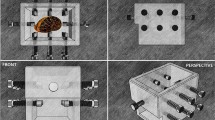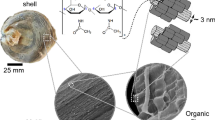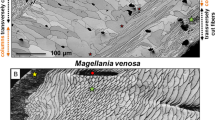Abstract
Unique skeletal formations of marine invertebrates, including representatives of Echinodermata, have the unique potential to serve as templates for bio-inspired materials chemistry, biomimetics, and materials science. The sand dollar Scaphechinus mirabilis (Agassiz, 1983) is widely distributed in the northwest of the Pacific Ocean from southern Japan to the Aleutian Islands. This animal is the main source of naphtochinone-based substances. These compounds have recently drawn medical attention for their use as cardiological and ophthalmological drugs. Unfortunately, after extraction of the naphtochinones, the residual skeletons and spines of the sand dollars were usually discarded. Here, we report the first method for the preparation of nanostructurally organized spines of S. mirabilis, using a simple enzymatic and hydrogen peroxide-based treatment. Application of this method opens the way for development of non-wasteful environmentally clean technology of sand dollars as well-known industrial marine invertebrates.










Similar content being viewed by others
References
Anufriev VP, Novikov VL, Maximov OB, Elyakov GB, Levitsky DO, Lebedev AV, Sadretdinov SM, Shvilkin AV, Afonskaya NI, Ruda MY, Cherpachenko NM (1998) Synthesis of some hydroxynaphthazarins and their cardioprotective effects under ischemia-reperfusion in vivo. Bioorg Med Chem Lett 8:587–592
Berger SB, Coelho AS, Oliveira VA, Cavalli V, Giannini M (2008) Enamel susceptibility to red wine staining after 35% hydrogen peroxide bleaching. J Appl Oral Sci 16(3):201–204
Burkhardt A, Hansmann W, Märkel K, Niemann H-J (1983) Mechanical Design in Spines of Diadematoid echinoids (Echinodermata, Echinoidea). Zoomorphol 102:189–203
D’yakonov AM (1949). Taxonomy of echinodermata in far east seas. Vladivostok, Izv TINRO 30:132
Dujardin E, Mann S (2002) Bio-inspeared materials. Chemistry Adv Mater 14:775–788
Ehrlich H, Douglas T, Scharnweber D, Hanke T, Born R, Bierbaum S, Worch H (2005) Hydroxyapatite Crystal Growth on Modified Collagen I-Templates in a Model Dual Membrane Diffusion System. J Inorg Gen Chem 631(10):1825–1830
Elyakov, G.B., Maximov, O.B., Mischenko, N.P., Koltsova, E.A., Fedoreev, S.A., Glebko, L.I., Krasovskaya, N.P., and Artyukov, A.A. (2001a) Histochrom and its therapeutic use in ophthalmology desease. US Patent 6,384,084
Elyakov GB, Maximov OB, Mischenko NP, Koltsova EA, Fedoreev SA, Glebko LI, Krasovskaya NP, Artyukov AA (2001b) Histochrom and its therapeutic use in myocardialinfarction and ischemic heart desease. US Patent 6(410):601
Falini G, Fermani S, Gazzano M, Ripamonti A (1998) Structure and morphology of synthetic magnesium calcite. J Mater Chem 8(4):1061–1065
Fedoreyev SA, Mischenko NP, Koltsova EA (2000) A new drug, histochrome, from the Sea Urchin. Abstr. 5th Intern. Marine Biotech. Conf., Townsville, Australia, 29 Sept.–4 Oct. 2000, p. 53
Fontaine AR, Hall BD (1981) Biocompatibility of echinoderm skeleton with mammalian cells in vitro: preliminary evidence. J Biomed Mater Res 15:61–71
Gayathri S, Lakshminarayanan R, Weaver JC, Morse DE, Kini M, Valiyaveettil S (2007) In vitro study of magnesium-calcite biomineralization in the skeletal materials of the seastar Pisaster giganteus. Chem Eur J 13:3262–3268
Kominami T, Takata H, Takaichi M (2001) Behavior of pigment cells in gastrula-stage embryos of Hemicentrotus pulcherrimus and Scaphechinus mirabilis. Dev Growth Differ 43:699–707
Kozlovskaya EP, Artyukov AA, Kozlovskiy AS, Vozshova EI, Kofanova NN, and Elyakov GB (1997) Wound-healing drug ‘Collagenase KK’ with a broad spectrum of activity. Patent RU2093166
Krafft C, Codrich D, Pelizzo G, Sergo V (2008) Raman and FTIR microscopic imaging of colon tissue: a comparative study. J Biophoton 1(2):154–169
Lebedev AV, Ivanova MV, Ruuge EK (2003) How do calcium ions induce free radical oxidation of hydroxy-1, 4-naphthoquinone? Ca2p stabilizes the naphthosemiquinone anion-radical of echinochrome A. Arch Biochem Biophys 413:191–198
Meldrum FC, Seshadri R (2000) Porous gold structures through templating by echinoid skeletal plates. Chem Comm 2000:29–30
Mischenko NP, Fedoreyev SA, Pokhilo ND, Anufriev VP, Denisenko VA, Glazunov VP (2005) Echinamines A and B, First aminated hydroxynaphthazarins from the Sea Urchin Scaphechinus mirabilis. J Nat Prod 68:1390–1393
Mooi R (1986) Structure and function of clypeasteroid miliary spines (Echinodermata, Echinoides). Zoomorphology 106:212–223
Nishibori K (1957) Studies on pigments of marine animals-III. Echinochrome A from the spine of sand-dollar, Echinarachnius mirabilis. Publ Seto Mar Biol Lab 22:708–712
Okazaki K, Dillaman RM, Wilbur KM (1981) Crystalline axes of the spine and test of the sea urchin Strongylocentrotus purpuratus: determination by crystal etching and decoration. Biol Bull 161:402–415
Peters BH (1985) The innervation of spines in the sea-urchin Echinus esculentus L. An electron-microscopic study. Cell Tissue Res 239:219–228
Pokhilo ND, Yakubovskaya AY, Denisenko VA, Anufriev VP (2006) Regiospecificity in the reaction of 2, 3-dichloronaphthazarins with azide anions. Synthesis of echinamine A—a metabolite produced by the sea urchin Scaphechinus mirabilis. Tetrahedron Lett 47:1385–1387
Politi Y, Arad T, Klein E, Weiner S, Addadi L (2004) Sea Urchin spine calcite forms via a transient amorphous calcium carbonate phase. Science 306:1161–1164
Seshadri R, Meldrum FC (2000) Bioskeletons as templates for ordered, macroporous structure. Adv Mater 12:1149–1151
Stonik VA (2005) Studies of natural compounds in the PIBOC, FEB RAS. Vestnik DVO RAN 4:138–144
Su X, Kamat S, Heuer AH (2000a) The structure of sea urchin spines, large biogenic single crystals of calcite. J Mat Sci 35:5545–5551
Su X, Kamat S, Heuer AH (2000b) The structure of sea urchin spines, large biogenic single crystals of calcite. J Mater Sci 35:5545–5551
Takeda S (2008) Mechanism maintaining dense beds of the sand dollar Scaphechinus mirabilis in northern Japan. J Exp Mar Biol Ecol 363:21–27
Tsipursky SJ, Buseck PR (1993) Structure of magnesian calcite from sea urchins. Am Mineralogist 78:775–781
Vecchio KS, Zhang X, Massie JB, Wang M, Kim CW (2007) Conversion of sea urchin spines to Mg-substituted tricalcium phosphate for bone implants. Acta Biomater 3:785–793
Wang S-M, Huang Q-Z, Wang Q-S (2005) Study on the synergetic degradation of chitosan with ultraviolet light and hydrogen peroxide. Carbohydrate Res 340:1143–1147
Xu AW, Ma Y, Cölfen H (2007) Biomimetic mineralization. J Mater Chem 17:415–449
Yakubovskaya AYa, Pokhilo ND, Mishenko NR, Anufriev VF (2007) Spinazarin and ethylspinazarin, pigments of the sea urchin Scaphechinus mirabilis. Russ Chem Bull 56:819–822
Acknowledgements
This study was supported by Erasmus Mundus External Co-operation program of the Europen Union 2009, by the DAAD (Grant Ref-325; A/08/72558), and by RMES (AVCP Grant No.8066). We thank Dr. S. V. Tomshich for the photograph of the living sand dollar, Ms. T. Yu. Gorpenchenko, Ms. P. Lutze and Ms. O. Trommer for technical help with light microscope and SEM images.
Author information
Authors and Affiliations
Corresponding author
Rights and permissions
About this article
Cite this article
Ehrlich, H., Elkin, Y.N., Artoukov, A.A. et al. Simple Method for Preparation of Nanostructurally Organized Spines of Sand Dollar Scaphechinus mirabilis (Agassiz, 1863). Mar Biotechnol 13, 402–410 (2011). https://doi.org/10.1007/s10126-010-9310-2
Received:
Accepted:
Published:
Issue Date:
DOI: https://doi.org/10.1007/s10126-010-9310-2




